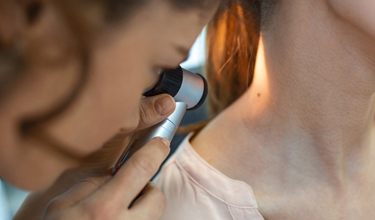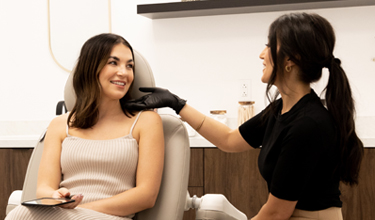Rosacea
Rosacea is a common chronic relapsing inflammatory skin disorder that is often misdiagnosed and untreated. It affects more than 16 million Americans and can seriously impair the quality of life of its sufferers.
Rosacea typically affects the central face of women more than men. The cause is unknown but is believed to involve changes in the nervous system, vascular system, and the skin microbiome. Specifically, Demodex mites and Staphylococcus may be triggers for development or flaring of rosacea, and ocular rosacea.
Dermodex mites are a natural part of the skin’s microbiome. They live in the hair follicles and meibomian glands of the eyelids. An abundance of dermodex mites can trigger an immune response in people with rosacea, or the inflammation may be caused by the bacteria associated with these mites.
What are the symptoms?
The first symptom is flushing. This is followed by persistent redness due to vasodilation (dilation or enlargement of the blood vessels in the face). Redness typically involves the middle of the face but may progress to involve the entire face, ears, neck, and upper chest. Telangiectasia (“broken blood vessels”) or spider veins are common. Skin inflammation in the form of papules, and pustules that are often confused with acne.
Additional symptoms include burning and stinging skin, dry skin, swelling, and eye involvement (Ocular rosacea). Ocular rosacea is characterized by watery or bloodshot eyes, a sensation of a foreign body in the eyes, burning, stinging, dryness, itching, light sensitivity, blurred vision and styes. Eye involvement can occur with or without a diagnosis of skin rosacea.
Plaques of thickened skin and enlarged pores are commonly found on the nose but can also affect the ears, chin, and forehead. This type is more common in men.
Symptoms typically come and go and can flare for weeks or months before diminishing. Triggers that can exacerbate the symptoms include hot foods and drinks, spicy foods, caffeine, acidic foods (tomatoes, fruit juice), sun exposure, alcohol consumption, extreme temperatures, stress, anger, and intense physical exercise. Some prescription medications that act on blood vessels (i.e. calcium channel blockers, Viagra, Cialis, etc.) can worsen rosacea.
How is rosacea diagnosed?
Diagnosis is based on the patient’s history and clinical features. Board-certified dermatologist Dr. Sheila Farhang will examine your skin and your eyes, order tests to rule out other diseases and allergic reactions and discuss your symptoms and personal medical history. Note that recent research suggests that about 50% of rosacea patients have small intestinal bacterial overgrowth or SIBO which when treated may provide marked improvements.
How is rosacea treated?
Rosacea can be challenging to treat, and therapies must be tailored to each patient’s symptoms. Treatment is designed to reduce signs and symptoms and prevent flares and worsening of the condition. A combination of topical and oral medications, lasers and light-based therapies can be effective.
Topical lotions include Metronidazole and Azelaic acid gel. Low-dose oral antibiotics are often prescribed because they decrease inflammation. If ocular rosacea is diagnosed, treatment will include warm compresses on the eyelids, regular eyelid cleansing, artificial tears, eye medications and low-dose antibiotics.
General measures include sun avoidance and sun protection, gentle facial cleansing products, skin barrier repair products that can reduce skin irritation, and avoiding triggers that can worsen rosacea.
Contact Dr. Sheila Farhange of Avant Dermatology in Tucson, Arizona to schedule a consultation to receive an accurate diagnosis and to learn about your treatment options.







 / 291 Reviews
/ 291 Reviews
socialize with avant
#naturalskin